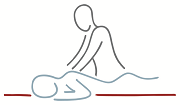Lower back pain is very common with office workers and drivers. Sitting all day will lead to the lower abdominal muscles becoming lazy as they do not need to support the torso. This makes them weak and inefficient. When standing, the weak Rectus Abdominis (6 pack muscle) is unable to maintain the correct position of the pelvis and it tends to tilt downwards (anteriorly). This pushes out your lumbar spine. Weakened abdominal muscles are also unable to contain the viscera and so the stomach will bulge forwards. This heavy load, particularly if you are also overweight, will move the body’s centre of gravity forward. To enable a level gaze to be maintained, your head will become pushed forwards so it is no longer in line with your spine.
This posture will develop over time and will affect the following muscles:
Lower back muscles will become short and strong through overuse and the hip flexors will also become shortened due to the anterior pelvic tilt. This tightness will cause lower back pain and tension.
Upper abdominal and chest muscles will tighten up which can affect your breathing.
With your head pushed forward for better viewing of the computer screen the muscles in the back of your neck can become lengthened and suffer from overuse as they support the extra weight. This can cause severe tension leading to pain and restricted movement.
This video shows how we can become “slumped” over time and which muscles are affected:
To alleviate these issues, I would ask you to consider the following actions:
Get your workstation assessed by your company’s occupational health team to make sure it is as ergonomic as possible. Computer screen at correct level, adjustable chair, lumbar support, foot rest and headphones will all help you to maintain the correct posture while seated. This improved posture will reduce some of the pressures being placed on the lower back and neck muscles. If your company does not have an occupational health department then you should talk to Human Resources about employing a consultant or specialist for the day so that all the staff can benefit from these assessments. Alternatively, there are plenty of self – help instructions on the internet. Standing up for part of the day can be beneficial. Variable height desks are available for this purpose and can help those with back problems. The investment by the company would be off- set by less sickness absence and a more motivated workforce who feels that the company cares about their health.
Take regular breaks from sitting at the computer. At least once an hour you should leave your desk and walk around for a few minutes, get a drink (water by preference) and stretch out your neck and shoulders. A few simple shoulder rolls and neck side bends along with standing up straight and stretching the legs would help to loosen the tight muscles and switch the lazy ones back on. Keeping hydrated with regular drinks will improve the overall efficiency of your body and reduce fatigue in the muscles.
If you are overweight then try to lose some of this excess weight by eating a healthy diet. The extra weight will be contributing to the pressure being put on your lower back muscles as well as your knees, hips and ankles. A healthy diet can lead to weight loss and may also improve sleep patterns and stress levels. Poor sleep and tensions from stress can lead to tightness in neck muscles which may be contributing to any back pain.
Add more movement:
Start to walk more and take some light exercise. The exercise will help with any weight loss aims as well as strengthening your postural muscles and reducing your stress levels. To make this a simple task that is more likely to lead to a change in behaviour, you should try to incorporate the exercise into your daily routine. Parking the car at the far side of the car park is a start. A quick couple of stretches after getting out of the car will also help. Taking the stairs between floors at work is next. You could try to get your colleagues involved too. Maybe walking meetings, a lunchtime stroll or an inter-department step challenge. These will all help with team building, networking and well – being in the workplace and are useful strategies for a company to follow to improve moral and overall health of employees.
If you already have an exercise regime, then incorporate more stretching of the hip flexors and hamstrings to counteract the tightness caused by sitting. You will also need to work on strengthening your gluteal and abdominal muscles to maintain correct posture and relieve tension in lower back. Talk to your coach, personal trainer or therapist for details on what exercises are best. Soft Tissue Therapy can help because massage will relax the tension, assisted stretching will improve the posture and remedial exercises will strengthen the weaknesses. If you would like to discuss, please get in touch.

